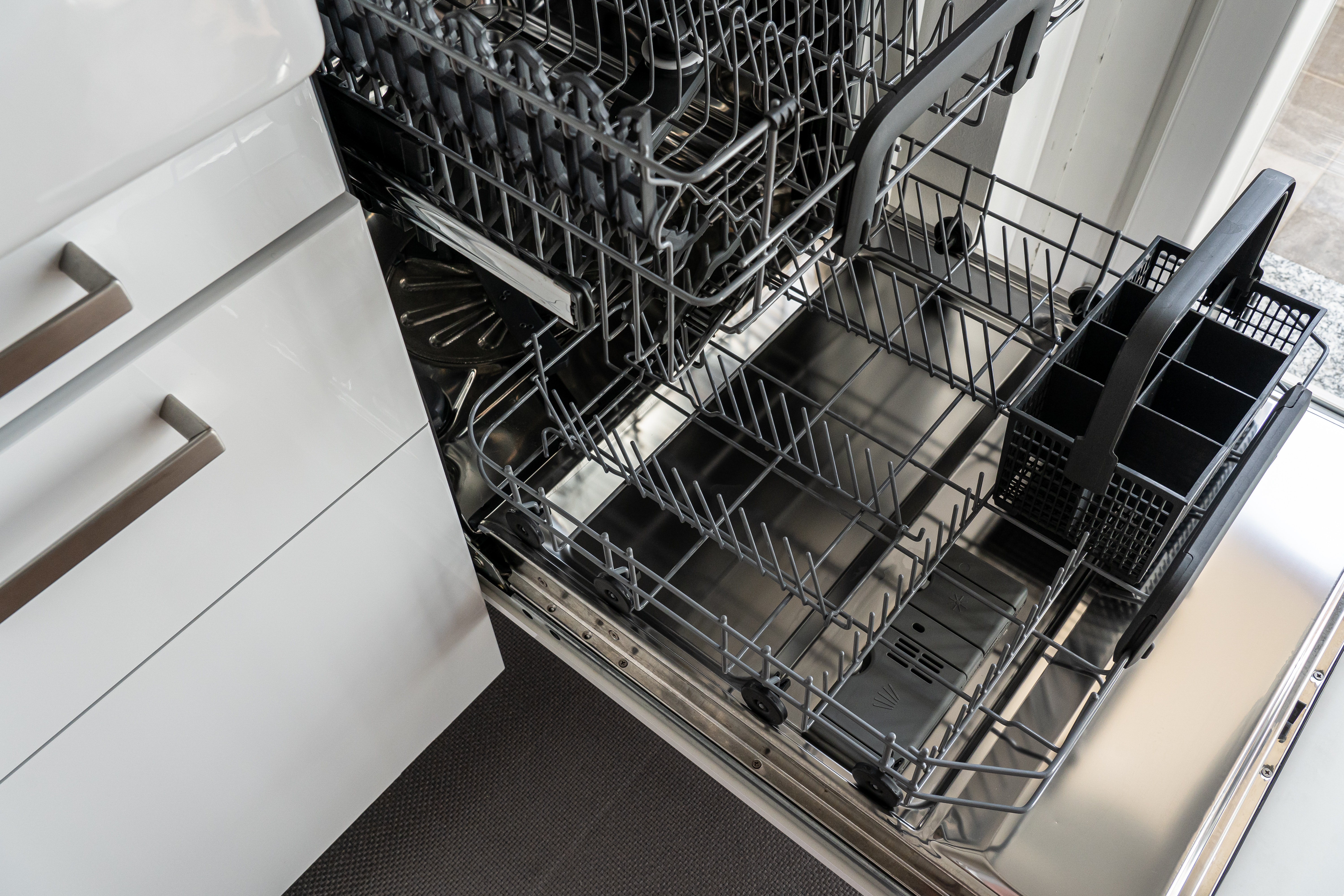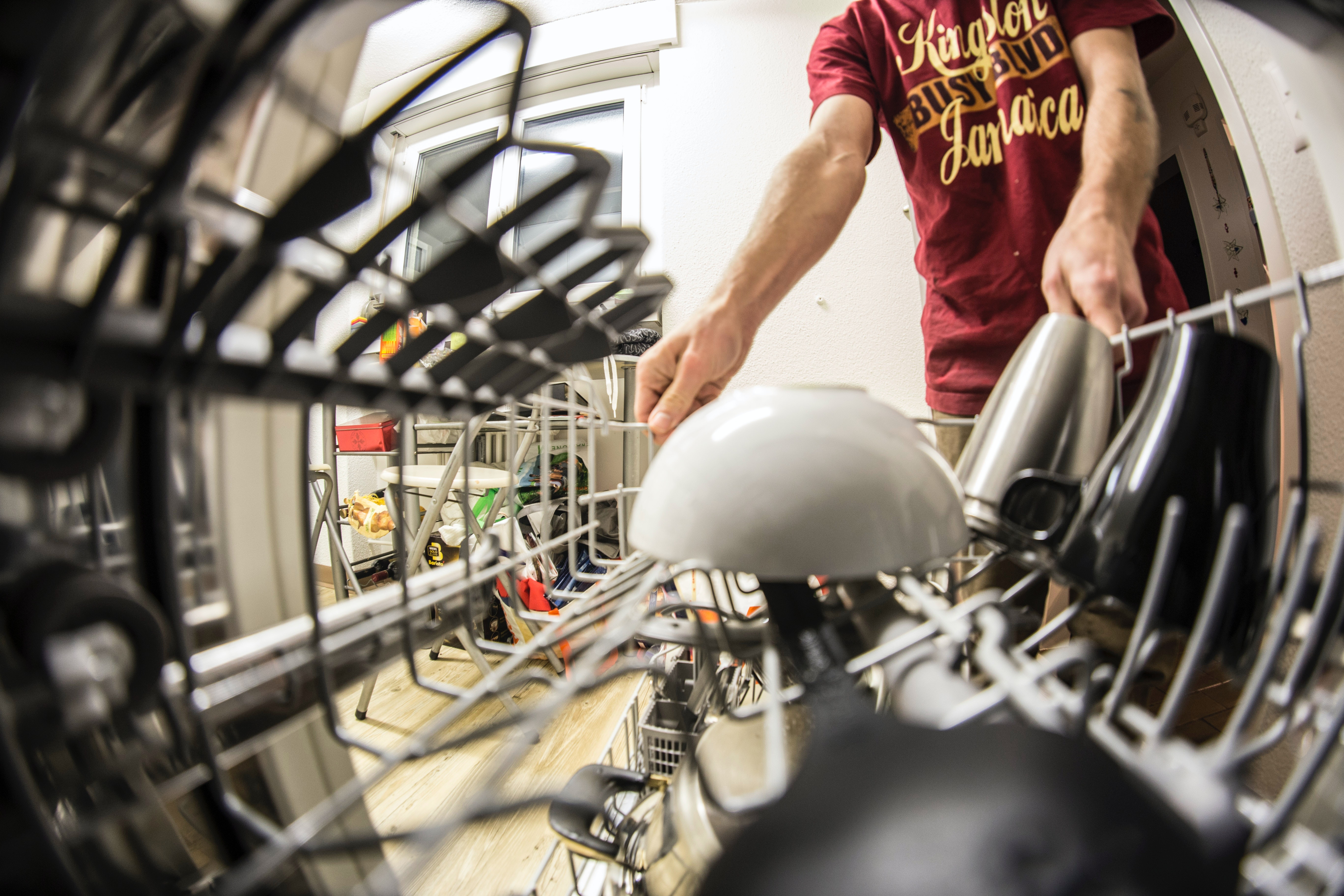WHAT CAN I DO TO GET THE MOST FROM MY DISHWASHER?
Cleaning your machine about once a month will remove any grease and lime scale deposits which can build up on the inside of the machine. Special dishwasher cleaners are available which are used when the machine is empty. These cleaners will often leave a fresh smell in the dishwasher too. If you want to have that fresh smell all the time, use a dishwasher freshener. These are usually supplied as hanging tags, which should be carefully positioned away from any moving arms. A freshener is essential if you load during the day and then run the machine at night.
HOW A DISHWASHER WORKS
Put simply, the dishwasher takes in cold water and heats it to a temperature far higher than possible for hand washing – usually above 130ºF. The dishwasher does not use a great deal of water, as it does not actually fill up. The water enters through a resin-based water softener, usually in the base of the machine. The water softener uses granular salt to maintain its efficiency and will require topping up regularly. Pumps force the water at high temperature into rotating arms containing spray jets. It is the force of the water that rotates the arms and enables the water and detergent to reach all parts of the load. After the programmed cycle of washing and rinsing is complete, heating elements dry the dishes, or they are left to drain dry, dependent on the programme you’ve chosen.
LOADING
crape off as much surface food as possible and place larger and dirtier items on the bottom rack with cups, glasses and less soiled items on the top rack. Load plates and glasses so they aren’t touching and put cutlery in the special basket, handles facing downwards.
These items can be washed in a dishwasher, with the following guidelines:
Glassware – Any ordinary glassware and ovenware such as Pyrex. Do not wash lead crystal glasses unless they carry a “dishwasher safe” label.
Tableware – Most everyday crockery is safe. Bone china usually has under-glaze decoration and should be safe. Avoid antique or hand-painted and over-glaze decorated items. If in doubt, check with the manufacturer.
Cutlery – Stainless steel and silver cutlery are normally suitable for machine washing, but it pays to rinse off any acidic food before loading to prevent any corrosion and, if possible remove the cutlery immediately after the cycle, to avoid prolonged exposure in a humid atmosphere. Do not mix steel and silver cutlery in the same basket and wash bone or wooden-handled items by hand.
Plastics – Check whether they are dishwasher safe and do not place in the lower rack, where the heating element may affect the plastic during drying.
Pans – Stainless steel is ideal for dishwashers. Aluminium can be washed in the machine, but may discolour during the rinsing. If in doubt, remove aluminium pans before the rinse cycle.
Always wash cast iron and wooden handled items by hand.
WHY DOES MY MACHINE HAVE A WATER SOFTENER?
If the water is soft (i.e. does not contain calcium particles), the detergent will work more effectively and there will be less streaking on dishes. Hard water can also block the washer jets with lime scale and cause deposits on heating elements, which will reduce the cleaning efficiency, increase electricity costs and shorten the life of the machine. All dishwasher manufacturers and detergent suppliers want you to get the best results from the machine – and soft water is one of the most important factors in achieving this. The way to ensure water remains soft is to regularly top up the reservoir with granular salt.
CAN I USE ORDINARY TABLE SALT?
No. Table, cooking, rock and sea salts may contain additives that can actually increase water hardness. Also, the fine consistency of some of these salts mean they are likely to clog when wet. Always use granular dishwasher salt because it is very pure and is the right consistency for use in your machine.
Granular salt is the ONLY type of salt that should be used to regenerate the softener. Be aware that some varieties of ‘dishwasher salt’ use Dead Sea salt. This variety may contain minute insoluble organic matter that may adversely affect the resin within your softener over time. If you are in doubt about the origins of the salt, ask the retailer or manufacturer.
CLOUDY GLASSES?
You can determine the cause of cloudy glassware by soaking a glass in vinegar for 5 minutes. If the cloudiness is removed it is due to hard water deposits; make sure the salt reservoir is topped up. Do not worry about over-filling it.
If the cloudiness is not removed, it is a permanent condition known as etching. In this situation, use less detergent and stop pre-washing. Dishwashing detergent needs a bit of soil to work on, otherwise it will tend to foam up.
WHAT DETERGENT SHOULD I USE?
All modern dishwasher detergents are formulated to work specifically in dishwashers. On no occasion should ordinary washing up liquid be used, as it will cause excess foam, which can result in a leak. If it is accidentally used, sprinkle ordinary salt into the chamber to disperse the resulting suds. Then rinse away the excess salt before using.
There are 3 main types of dishwasher detergent – Powder, liquid or gel and tablets. Which one you choose will be down to personal preference, but most people find tablets very convenient, although using powder is usually more economical and liquids are less abrasive on more delicate items.
WHAT IS RINSE AID?
Rinse Aid is added to a special compartment in the machine and a very small amount is released during the final hot rinse cycle, to reduce the formation of water droplets on crockery etc and so ensures that the water dries away properly and evenly to avoid leaving smears.
Call Absolute Appliance Repair NOW if you have any problems with your dishwasher!
Phone lines
(415) 831-1259 San Francisco
(415) 388-0690 Marin County
(650) 525-0512 South SF / Daly City / Pacifica

 Dishwashers rule for more reasons than getting rid of dishpan hands.
Dishwashers rule for more reasons than getting rid of dishpan hands.
